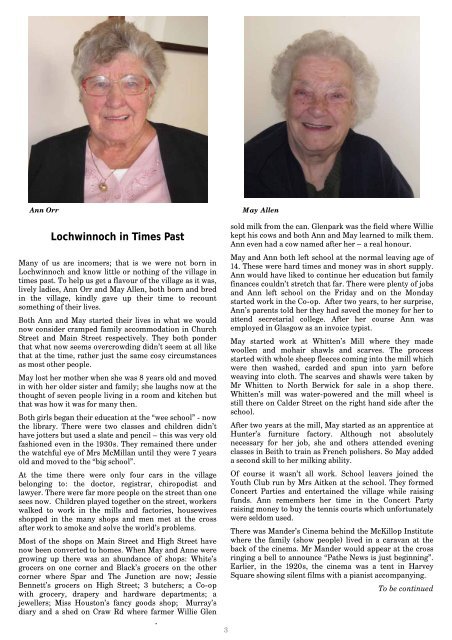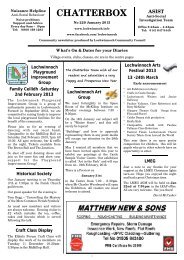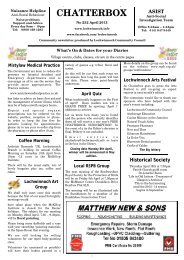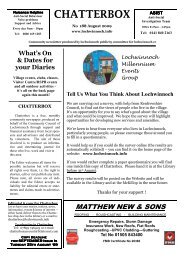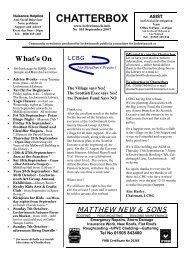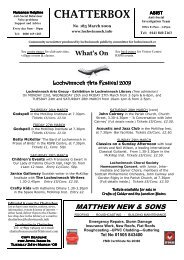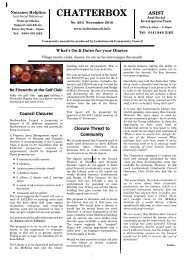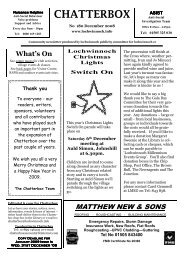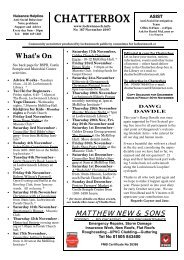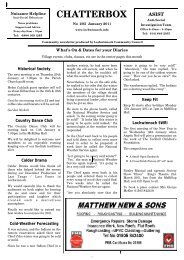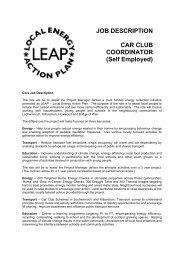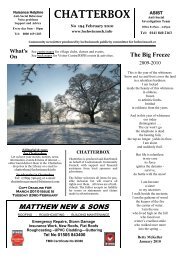CHATTERBOX - Lochwinnoch Online
CHATTERBOX - Lochwinnoch Online
CHATTERBOX - Lochwinnoch Online
Create successful ePaper yourself
Turn your PDF publications into a flip-book with our unique Google optimized e-Paper software.
Ann Orr May Allen<br />
<strong>Lochwinnoch</strong> in Times Past<br />
Many of us are incomers; that is we were not born in<br />
<strong>Lochwinnoch</strong> and know little or nothing of the village in<br />
times past. To help us get a flavour of the village as it was,<br />
lively ladies, Ann Orr and May Allen, both born and bred<br />
in the village, kindly gave up their time to recount<br />
something of their lives.<br />
Both Ann and May started their lives in what we would<br />
now consider cramped family accommodation in Church<br />
Street and Main Street respectively. They both ponder<br />
that what now seems overcrowding didn’t seem at all like<br />
that at the time, rather just the same cosy circumstances<br />
as most other people.<br />
May lost her mother when she was 8 years old and moved<br />
in with her older sister and family; she laughs now at the<br />
thought of seven people living in a room and kitchen but<br />
that was how it was for many then.<br />
Both girls began their education at the “wee school” - now<br />
the library. There were two classes and children didn’t<br />
have jotters but used a slate and pencil – this was very old<br />
fashioned even in the 1930s. They remained there under<br />
the watchful eye of Mrs McMillan until they were 7 years<br />
old and moved to the “big school”.<br />
At the time there were only four cars in the village<br />
belonging to: the doctor, registrar, chiropodist and<br />
lawyer. There were far more people on the street than one<br />
sees now. Children played together on the street, workers<br />
walked to work in the mills and factories, housewives<br />
shopped in the many shops and men met at the cross<br />
after work to smoke and solve the world’s problems.<br />
Most of the shops on Main Street and High Street have<br />
now been converted to homes. When May and Anne were<br />
growing up there was an abundance of shops: White’s<br />
grocers on one corner and Black’s grocers on the other<br />
corner where Spar and The Junction are now; Jessie<br />
Bennett’s grocers on High Street; 3 butchers; a Co-op<br />
with grocery, drapery and hardware departments; a<br />
jewellers; Miss Houston’s fancy goods shop; Murray’s<br />
diary and a shed on Craw Rd where farmer Willie Glen<br />
3<br />
sold milk from the can. Glenpark was the field where Willie<br />
kept his cows and both Ann and May learned to milk them.<br />
Ann even had a cow named after her – a real honour.<br />
May and Ann both left school at the normal leaving age of<br />
14. These were hard times and money was in short supply.<br />
Ann would have liked to continue her education but family<br />
finances couldn’t stretch that far. There were plenty of jobs<br />
and Ann left school on the Friday and on the Monday<br />
started work in the Co-op. After two years, to her surprise,<br />
Ann’s parents told her they had saved the money for her to<br />
attend secretarial college. After her course Ann was<br />
employed in Glasgow as an invoice typist.<br />
May started work at Whitten’s Mill where they made<br />
woollen and mohair shawls and scarves. The process<br />
started with whole sheep fleeces coming into the mill which<br />
were then washed, carded and spun into yarn before<br />
weaving into cloth. The scarves and shawls were taken by<br />
Mr Whitten to North Berwick for sale in a shop there.<br />
Whitten’s mill was water-powered and the mill wheel is<br />
still there on Calder Street on the right hand side after the<br />
school.<br />
After two years at the mill, May started as an apprentice at<br />
Hunter’s furniture factory. Although not absolutely<br />
necessary for her job, she and others attended evening<br />
classes in Beith to train as French polishers. So May added<br />
a second skill to her milking ability.<br />
Of course it wasn’t all work. School leavers joined the<br />
Youth Club run by Mrs Aitken at the school. They formed<br />
Concert Parties and entertained the village while raising<br />
funds. Ann remembers her time in the Concert Party<br />
raising money to buy the tennis courts which unfortunately<br />
were seldom used.<br />
There was Mander’s Cinema behind the McKillop Institute<br />
where the family (show people) lived in a caravan at the<br />
back of the cinema. Mr Mander would appear at the cross<br />
ringing a bell to announce “Pathe News is just beginning”.<br />
Earlier, in the 1920s, the cinema was a tent in Harvey<br />
Square showing silent films with a pianist accompanying.<br />
To be continued


